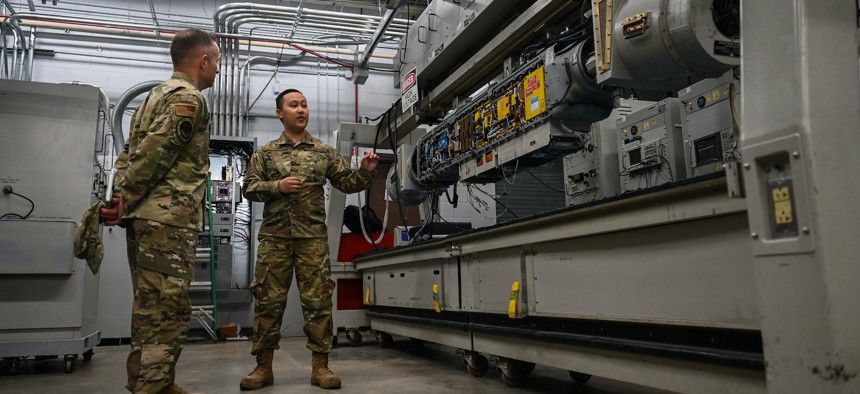
U.S. Air Force Command Chief Master Sgt. John Storms, Air Combat Command, listens to a brief by members of the 36th Electronic Warfare Pod Shop at Eglin Air Force Base, Fla., Nov. 30, 2022. U.S. Air Force / 1st Lt. Benjamin Aronson
One way the Air Force is filling electronic-warfare gaps: hiring interns
The 350th Spectrum Warfare Wing is working with universities to recruit young talent for now—and maybe later.
The Air Force’s electronic warfare wing is working to reduce its personnel vacancies with new hires and an internship program—but it still needs hundreds more to meet growing mission needs.
“We have increased our footprint,” Capt. Benjamin Aronson, a spokesperson for the 350th Spectrum Warfare Wing, told Defense One on the sidelines of the Air, Space & Cyber conference.
Earlier this year, the wing’s commander, Col. Josh Koslov, said he needed 400 more people as the two-year-old organization grew to meet its missions. The 350th is chipping away at that deficit, adding 100 people to fill jobs in science and engineering, human resources, financial management, IT and cybersecurity, equipment management, and security.
But the young wing is expanding, which means vacancies crop up as soon as others are filled.
“We currently have 386 vacant civilian positions, which are projected to be filled over the next few years across multiple [electronic warfare] platforms,” Staff Sgt. Ericka Woolever, 350th Wing spokesperson told Defense One via email.
The 350th Spectrum Warfare Wing is in charge of delivering electronic warfare capabilities to the Air Force. The wing has one unit that is prime for expansion and shares the bulk of the vacancies: the 950th Spectrum Warfare Group, which is set to stand up by 2027 at Robins Air Force Base in Georgia. That base is part of the Air Force’s effort to replace the aging Joint Surveillance Target Attack Radar System, or JSTARS, aircraft.
That group needs about 300 engineers, electronic warfare officers, programmers, intelligence professionals, tacticians, mission planners, weapons experts, and aircraft operators for various aircraft and will take over the service’s Combat Shield effort, which tests aircraft EW systems.
Woolever said wing officials are recruiting at local events for roles in STEM, IT, and program management at Eglin Air Force Base in Florida, and Joint Base San Antonio, Texas. To acquire young talent, the 350th Wing brought on seven interns with the ultimate goal of hiring them as part of the Virtual Institutes for Cyber and Electromagnetic Spectrum Research and Employ, or VICEROY, program.
This summer’s cohort used AI to reprogram aircraft, developed threat test models for F-35s and bombers, and other tasks.
The program is a collaboration with the Air Force Research Laboratory, the Griffiss Institute, and 22 colleges and universities to bring on students that are “security-clearance eligible and possess job-ready DOD cybersecurity skills” once they graduate, Woolever said.
“And that's just an example of the way that we are looking to not only attract younger new talent, through internships but also actually hire them after,” Aronson said.
NEXT STORY: Cyber on the battlefield is about more than IT




